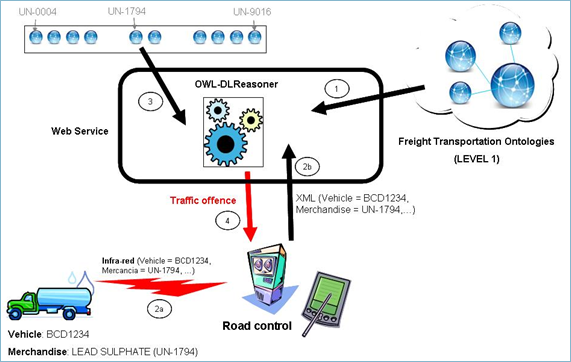Therefore the main objective of this research project was to develop a system for representing a particular field, the goods transport, with a well-defined semantics based on laws that affect this particular field. The use of this semantics allows a formalized knowledge that facilitates the development of a conceptual infrastructure, for the exchange of information and control of goods between trucks and external entities, automatically and through wireless connections between on-board devices of the vehicle and the network infrastructure of roads.
The transportation of goods through a country or between different countries is suffering deficiencies regarding to the control of goods along the route from the origin to the destination. The current procedure simply consists (in most cases) in filling in a form or a loadsheet. The control of goods is only made in certain borders inspection posts or when the relevant authorities required it. This may become a problem for the fulfillment of the laws of each country (different restrictive laws for the same type of goods) or even when this law is consciously broken.
The idea of this project is to annotate at the place of origin or at any other intermediate point the load of the truck, where this one may suffer a modification or even where the cabin is separated from its initial truck, of the entire load kept inside the vehicle. This annotation is based on the use of ontologies which allow any type of specification of goods, through the creation of specific vocabularies. Similarly, the objective is the creation of ontologies that are based on legal documentation in this field, as well as other types of related ontologies that may affect the proper operation of this type of transport.
To include the implementation of the ontology in a particular system allows the standardised exchange of information with external systems as the authorities used it.
With this system is aimed also that in any point of the itinerary and without the need of stopping the vehicle by mobile units or failing this by fixed controls located in strategic places such as tunnel, bridges, etc. the exchange of information between the vehicle and any external device can be made, which will be capable of interrogating the system installed in the vehicle, finding out the type and quantity of the goods that it is transporting, as well as the related data with the particular vehicle. Once this information is checked, the legality of the load will be find out, considering various factors such as legal aspects regarding to the type of load, weight excess, continuous hours of travel, etc.
The objective is that the exchange and processing of information will be made automatically and transparently, through devices that exchange information based on XML markup languages and duly specified by the construction of a model that define both the elements and its relations. The possibility of offering this information in different formats is currently under research.
Related publication


Ministry of Education and Sciene













